Services on Demand
Journal
Article
Indicators
-
 Cited by SciELO
Cited by SciELO
Related links
-
 Similars in
SciELO
Similars in
SciELO
Share
Boletim do Museu Paraense Emílio Goeldi Ciências Humanas
Print version ISSN 1981-8122
Bol. Mus. Para. Emilio Goeldi Cienc. Hum. vol.1 no.1 Belém Apr. 2006
Orações subordinadas em Karajá
Eduardo Rivail Ribeiro
Universidade Federal de Goiás. Museu Antropológico. Pesquisador associado. Goiânia, Goiás, Brasil (kariri@gmail.com)
ABSTRACT
Karajá, a Macro-Jê language spoken in Central Brazil, presents a typologically uncommon device to signal relativization: stress shift. Despite its productivity, such mechanism is not mentioned in any of the previous descriptive or theoretical works dealing with Karajá grammar. In describing relativization (and subordination in general) in Karajá, this paper presents an overview of the language's grammar, including the semantic properties of postpositions (which play an essencial role in the creation of adverbial clauses, including converbs), lexical nominalization, and inflectional morphology.
Keywords: Subordination. Relativization. Non-concatenative morphology. Nominalization.
RESUMO
O Karajá, língua indígena do Brasil Central, apresenta um mecanismo tipologicamente incomum para marcar relativização: mudança de acento. Apesar de sua produtividade, tal mecanismo não é mencionado em nenhum dos trabalhos anteriores, teóricos ou descritivos, que tratam da sintaxe Karajá. Ao descrever as estratégias de relativização (e subordinação, em geral) em Karajá, este artigo apresenta uma visão panorâmica da gramática da língua, descrevendo as propriedades semânticas das posposições (que desempenham um papel essencial na criação de orações subordinadas adverbiais, incluindo converbos), nominalização lexical, e morfologia flexional.
Palavras-chave: Subordinação. Relativização. Morfologia não concatenativa. Nominalização.
INTRODUCTION
This paper describes relative clauses in Karajá, a Macro-Jê language spoken in Central Brazil1. Since relative clauses in this language share fundamental properties with both complement clauses and (the functional equivalents of) adverbial clauses, these will also be treated in this paper. Although this study is mainly concerned with subordinate clauses proper (that is, complements or modifiers which present the internal structure of a full clause), it will also briefly discuss nominalized complements, very common functional equivalents of subordinate clauses in Karajá.
Relative clauses in Karajá are basically formed by 'stress shift' in the verb, providing an interesting example of non-concatenative morphology. As we will see, a typical finite verb in Karajá presents tense-aspect clitics, which are unstressed. In independent clauses, the stress falls ordinarily on the last syllable of the verb stem (1). In relative clauses, however, the stress shifts to the tense-aspect clitic (2).
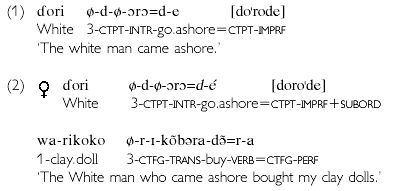
Before describing the properties of subordinate clauses in Karajá, some background information on the language's phonology and morphology will be provided (Background). A section will be dedicated to the description of the properties of relative clauses, providing a background for the discussion of complement clauses (Complementation) and postpostional clauses (Adverbial Clauses), which in Karajá play most of the functions traditionally associated with adverbial clauses. A section describes nominalized complements. The last section provides a summary of the paper.
BACKGROUND
Before describing the characteristics of subordinate clauses in Karajá, a few remarks on the language's phonology, morphology, and syntax are in order.
Female male and male speech
Karajá presents remarkable differences between male and female speech (FORTUNE, D.; FORTUNE, G., 1975; BORGES, 1997), which can be generally accounted for by fairly regular phonological rules (throughout this paper, the source of the data will be indicated by the symbols ♀ 'female' and ♂ 'male', whenever necessary). Female speech can be considered as more conservative, male speech being characterized, in general, by the deletion of a velar stop occurring in the corresponding female speech form (3). The deletion of the velar stop can make possible the fusion between vowels (3d-f).
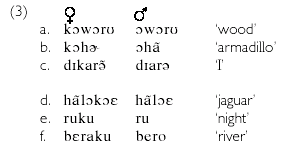
Phonology
The primary stress falls ordinarily on the last syllable of a stem (4a). Secondary stress is generally assigned on an iambic, right-to-left pattern to every other syllable (4b).
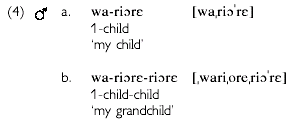
As the examples show, in order to fit the iambic pattern, the original stress pattern of a stem may be rearranged under compounding (4b), as well as under suffixation, since all derivational suffixes are stressed. On the other hand, a number of grammatical and discourse morphemes – including tense and aspect markers (4c), the indefinite article ♀ =dõ,♂=õ (5a), and most postpositions (5b) – are unstressed, and thus do not alter the stress of the stem to which they attach:

Examples in the following sections will be given in phonemic transcription only – except for stress, which will be indicated whenever relevant for the topic of this paper. Although space considerations prevents from providing a more complete picture of Karajá phonology, a few notes on the pronunciation of the examples may be necessary. The voiced stops /b/ and /d/ are fully nasalized before nasal vowels and /a/: 'stone'
'stone'  The minimal surface word in Karajá is bimoraic. In order to comply with the bimoraic minimality constraint, monosyllabic stems duplicate their vowels when occuring by themselves in a phrase. Thus, the stem
The minimal surface word in Karajá is bimoraic. In order to comply with the bimoraic minimality constraint, monosyllabic stems duplicate their vowels when occuring by themselves in a phrase. Thus, the stem  'firewood' in example (5) is pronounced as
'firewood' in example (5) is pronounced as 
One of the most remarkable characteristics of Karajá phonology is vowel harmony, which consists in the regressive spreading of the [+ATR] feature specification to vowels that would otherwise surface as [-ATR] (RIBEIRO, 2000, 2002). Vowel harmony can be triggered by any morpheme containing a [+ATR] vowel, including clitics such as the imperfective auxiliary =r-e, as seen in examples (1) and (2). Another common process is palatalization, whereby a dental or alveolar consonant becomes palatalized when contiguous to the [high, +ATR] vowels /i/  and /u/. The dental fricative /θ/ is palatalized in contiguity to these vowels: waθi-θa 'fishing line'
and /u/. The dental fricative /θ/ is palatalized in contiguity to these vowels: waθi-θa 'fishing line'  Likewise, the alveolar stop /d/ and the lateral /l/ become voiced alveopalatal affricates in those same environments: di 'aquatic plant (sp.)'
Likewise, the alveolar stop /d/ and the lateral /l/ become voiced alveopalatal affricates in those same environments: di 'aquatic plant (sp.)'  hãdu 'paca (a type of mammal)' [ha)
hãdu 'paca (a type of mammal)' [ha)  The alveolar implosive
The alveolar implosive  becomes a voiceless alveopalatal when preceding a [high, +ATR] vowel:
becomes a voiceless alveopalatal when preceding a [high, +ATR] vowel:  'sun'
'sun'  In addition, in the Southern and Northern Karajá dialects, the velar stop /k/ is palatalized when preceded by /i/: ♀ rikoko, ♂ rikoo 'clay doll'
In addition, in the Southern and Northern Karajá dialects, the velar stop /k/ is palatalized when preceded by /i/: ♀ rikoko, ♂ rikoo 'clay doll' 
Verb morphology
Contrasting with a fairly simple noun morphology (consisting solely of possessive prefixes and derivational suffixes), the Karajá verb inflects for subject agreement, direction, and valence; in addition, pronominal direct objects (including the reflexive morpheme) are prefixed to the verb stem. The examples (6) to (8) illustrate the distribution of the inflectional morphemes in the verb word and the pragmatically unmarked word order in the language (SOV; with oblique NPs tending to occur pre-verbally).
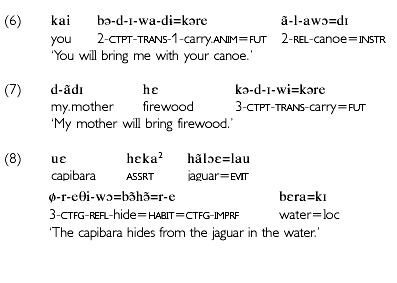
Person agreement displays a strictly nominative pattern, with the verb always agreeing with the subject, be it intransitive (9a) or transitive (9b). Person agreement markers are distributed into two different sets, one occurring in the realis (present and past tenses) and the other in the irrealis (future, potential, and admonitory). These prefixes are listed in Table 13.
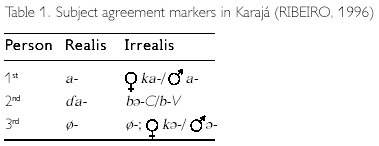

Another category expressed by the verb is direction, indicating whether an event is seen as occuring towards or away from a deitic center (by default, the location of the speaker; see Ribeiro (2002a, 2004) for discourse-oriented motivations for the assignment of the role of deictic center). Centripetal direction ('hither') is marked by the prefix d- (10a) and (11a), whereas centrifugal direction ('thither') is marked by r- (10b) or by a zero allomorph (11b):

Karajá verbs are lexically either transitive or intransitive, and any valence change must be morphologically indicated. Intransitive verbs (that is, those that do not take a direct object as one of their arguments) are generally marked by the prefix a- (12a) or by a zero allomorph (12b). Transitive verbs are marked by the prefix I- (13a), and may have their valence decreased through passivization (13b), antipassivization (13c), and reflexivization (13d). Intransitive verbs, on the other hand, may have their valence increased through causativization or through oblique promotion, which are derivational processes (RIBEIRO, forthcoming a).
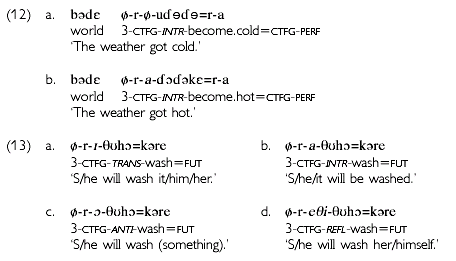
As we have seen, pronominal direct objects are prefixed to the verb stem. The series of direct-object prefixes is partially the same as that which occurs with nouns. However, except for the first person (14a), the direct-object prefixes are rather irregular. Notice that third person object is not marked4 (or is marked by a zero prefix), and that the transitivity prefix is dropped with second-person objects:
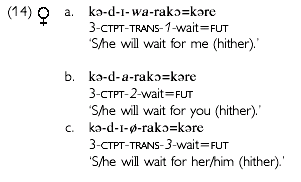
Tense and aspect do not occur as inflectional categories in Karajá, being indicated by auxiliaries and particles which cliticize to the verb stem (Table 2). Although such morphemes have been traditionally analyzed as suffixes (FORTUNE, D.; FORTUNE, G., 1964; FORTUNE, 1970; FORTUNE, 1973; MAIA, 1998), a more careful analysis reveals that they are indeed clitics (RIBEIRO, 1996)5. As mentioned, these morphemes are intrinsically unstressed6.
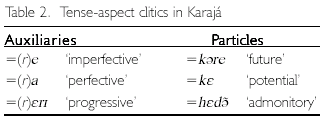
Noun morphology
The only prefixes which occur with nouns are possessive morphemes. All noun (and most verb) stems may be grouped into two lexical classes, arbitrarily labeled class I and class II (RIBEIRO, 1996). The main difference between class I and class II noun stems is in the series of personal prefixes they take, as illustrated by the paradigms for class I and class II stems given in Tables 3 and 4.
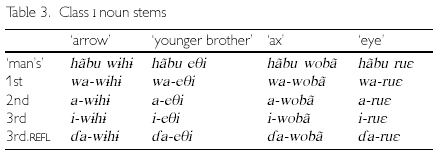
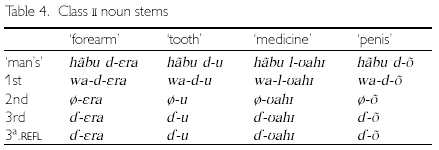
The series of personal prefixes occurring with class I and class II stems are summarized in Table 5. Whereas class I prefix series distinguishes a reflexive third person  from a non-reflexive one (i-), class II series has only one third person prefix
from a non-reflexive one (i-), class II series has only one third person prefix  which covers the range of meanings of both reflexive and non-reflexive third persons. Furthermore, class II stems present a prefix d- or l- in the first person, in the 'citation form,' and when preceded by a nominal possessor7. The function of this prefix is synchronically opaque, but its distribution resembles that of the so-called 'relational prefixes', 'linking morphemes' which are described for other Macro-Jê languages (Karirí, Boróro, Ofayé, and the Jê family), as well as for Tupí and Carib languages (RODRIGUES, 1994, 2000; RIBEIRO, forthcoming b). The characteristics of these prefixes will be further discussed in A note on relational prefixes.
which covers the range of meanings of both reflexive and non-reflexive third persons. Furthermore, class II stems present a prefix d- or l- in the first person, in the 'citation form,' and when preceded by a nominal possessor7. The function of this prefix is synchronically opaque, but its distribution resembles that of the so-called 'relational prefixes', 'linking morphemes' which are described for other Macro-Jê languages (Karirí, Boróro, Ofayé, and the Jê family), as well as for Tupí and Carib languages (RODRIGUES, 1994, 2000; RIBEIRO, forthcoming b). The characteristics of these prefixes will be further discussed in A note on relational prefixes.
Table 5. Possessive prefixes8
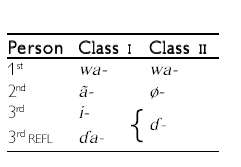
Verb stems may also be distributed between both lexical classes. When nominalized, they take exactly the same series of prefixes summarized in Table 5. Stems from both classes also differ in terms of verbal inflection. While class I intransitive verbs such as  'to become hot' (12a) are generally marked by the prefix a-, class II intransitive verbs such as
'to become hot' (12a) are generally marked by the prefix a-, class II intransitive verbs such as  'to become cold' (12b) are marked by a zero allomorph. In addition, transitive class II stems occur with the prefixes l- and d- (mostly when preceded by an incorporated object) or
'to become cold' (12b) are marked by a zero allomorph. In addition, transitive class II stems occur with the prefixes l- and d- (mostly when preceded by an incorporated object) or  9:
9:
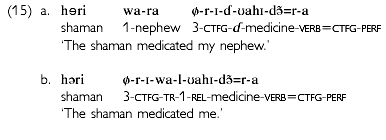
A NOTE ON RELATIONAL PREFIXES
Considering that the distinction between class I and class II stems plays an important role in inflectional morphology, a note on the distribution of relational prefixes (which underlies the distinction between both classes) will be necessary. Although the characteristics of these morphemes may vary to a certain degree in the different languages, I find it useful, for comparative purposes, to preserve the label 'relational prefix', since such morphemes seem to be reconstructible for Proto-Macro-Jê (RIBEIRO, 2003)10. In most families for which the existence of relational prefixes has been proposed, they tend to involve an alternation between a 'hard' and a 'soft' prefix  11.
11.
In languages in which the distinctions between hard and soft forms have not been obliterated by phonological, morphological, or semantic causes, their distribution is straightforward. The soft form occurs whenever a noun, verb, or adposition is preceded by its syntactic argument (that is, the absolutive argument of a verb, the object of a postposition, or the possessor of a noun). In Tupinambá, according to Rodrigues (1994), the prefix r- occurs when either a noun, a descriptive verb, a transitive verb, or a postposition is immediately preceded by a determining noun (15a), whereas the prefix s- (15b) "occurs when the determined item is not immediately preceded by the determining one". The parallel with some class II stems in Karajá is notable, as shown by the examples involving the stem e 'wing, feather' (16):
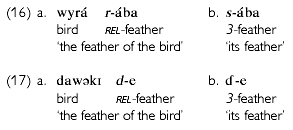
In his earlier analyses of Tupinambá morphology, Rodrigues (1953) labels as 'relational prefix' (prefixo de relação) only the prefix r- (an analysis which I preserve for Karajá  as well as their equivalents in other Macro-Jê languages). However, in more recent analyses he extends this term to s-, which is described as a relational prefix marking 'non-contiguity' (as opposed to r-, a marker of 'contiguity'). Such an analysis tends to complicate a subject matter which is mostly trivial. As my translation of the examples suggests, the 'noncontiguity' marker is probably better analyzed as a third person marker. Stems showing the opposition illustrated are generally inherently relational (that is, they must occur with a syntactic argument), such as obligatorily possessed nouns (including kinship and body-part terms), postpositions, and verbs. Since these stems tend to lack an unmarked 'citation form,' this role is commonly played by third-person forms, hence the 'coincidence' between third-person and the so-called non-contiguity markers12.
as well as their equivalents in other Macro-Jê languages). However, in more recent analyses he extends this term to s-, which is described as a relational prefix marking 'non-contiguity' (as opposed to r-, a marker of 'contiguity'). Such an analysis tends to complicate a subject matter which is mostly trivial. As my translation of the examples suggests, the 'noncontiguity' marker is probably better analyzed as a third person marker. Stems showing the opposition illustrated are generally inherently relational (that is, they must occur with a syntactic argument), such as obligatorily possessed nouns (including kinship and body-part terms), postpositions, and verbs. Since these stems tend to lack an unmarked 'citation form,' this role is commonly played by third-person forms, hence the 'coincidence' between third-person and the so-called non-contiguity markers12.
In Karajá, the use of  as linking morphemes is still evident in cases such as e 'feather', which is an obligatorily possessed noun, and with verbs (15). However, with a number of class II stems – such as
as linking morphemes is still evident in cases such as e 'feather', which is an obligatorily possessed noun, and with verbs (15). However, with a number of class II stems – such as  'hand',
'hand',  'bracelet', d-u 'tooth' –, forms with the prefixes
'bracelet', d-u 'tooth' –, forms with the prefixes  have a more generic, 'citational' use. This is probably a consequence of a general, ongoing process of weakening of the opposition between obligatorily possessed and optionally possessed nouns in Karajá, which affects not only class II stems, but also class I stems. Thus, besides those stems that are obligatorily possessed (such as
have a more generic, 'citational' use. This is probably a consequence of a general, ongoing process of weakening of the opposition between obligatorily possessed and optionally possessed nouns in Karajá, which affects not only class II stems, but also class I stems. Thus, besides those stems that are obligatorily possessed (such as  'tip', and
'tip', and  I 'face') and those that are optionally possessed (such as
I 'face') and those that are optionally possessed (such as  'hand',
'hand',  'medicine',
'medicine',  'flower', and wa 'foot'), there are a number of stems whose behavior is subject to variation among individual speakers13. This is the case of the stems
'flower', and wa 'foot'), there are a number of stems whose behavior is subject to variation among individual speakers13. This is the case of the stems  'leg, bone', for which younger speakers tend to coin unmarked citation forms, while older speakers use third-person forms for that purpose.
'leg, bone', for which younger speakers tend to coin unmarked citation forms, while older speakers use third-person forms for that purpose.
Derivational morphology
As we have seen, there are clear inflectional criteria to distinguish nouns from verbs in Karajá. There are also clear derivational devices to create verbs from noun stems, and vice-versa. Virtually any noun can be verbalized by the suffix  (18). On the other hand, there are a number of morphological devices to derive nouns from verbs (deverbal nouns will be discussed in Nominalized complements).
(18). On the other hand, there are a number of morphological devices to derive nouns from verbs (deverbal nouns will be discussed in Nominalized complements).

Postpositions
Considering that postpositions play an important role in some subordinate clauses, this section provides a succint description of their morphological and semantic characteristics. There are at least ten postpositions in Karajá (Table 6). Except for the reflexive (marked by the prefix  an allomorph of the reflexive prefix which occurs with verbs), postpositions take in general the same series of prefixes as class I noun stems (Table 7).
an allomorph of the reflexive prefix which occurs with verbs), postpositions take in general the same series of prefixes as class I noun stems (Table 7).
Table 6. Karajá postpositions16
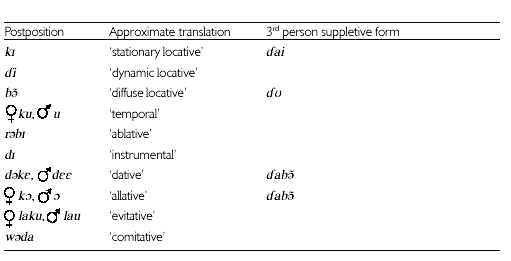

Exceptions are the postposition  which takes the prefix
which takes the prefix  in the second person (the only occurrence of this prefix whatsoever) and the allative postposition
in the second person (the only occurrence of this prefix whatsoever) and the allative postposition  which does not seem to occur with prefixes14. In addition,
which does not seem to occur with prefixes14. In addition,  'diffuse locative',
'diffuse locative',  'stationary locative', and
'stationary locative', and  'dative' present suppletive pronominal forms for the third person
'dative' present suppletive pronominal forms for the third person  15. Most of the postpositions are unstressed, with the exception of the dative
15. Most of the postpositions are unstressed, with the exception of the dative  and the the evitative ♀laku (♂lau).
and the the evitative ♀laku (♂lau).
Considering the semantic idiosyncrasies that generally caracterize adpositions, naming them is only a first attempt towards defining their semantic properties17. Although the translation of some of the postpositions listed is rather straightforward (vis-a-vis their approximate translation given in Table 6), a number of them require further explanation (either because of their highly polysemic nature, or because of the semantic subtleties that differentiate them). Although a complete account of the semantic properties of postpositions is beyond the scope of this paper, a brief explanation of the meanings most commonly associated with some of them shall be helpful in understanding their use with subordinate clauses.
The evitative postposition indicates what is to be avoided or feared, marking the oblique complements of verbs such as  'to be freightened' (19) and
'to be freightened' (19) and  'to hide', example (8)18. An example of the temporal postposition ('when') is given in (20). Besides indicating source ('from'), the ablative postposition marks objects of comparison (21).
'to hide', example (8)18. An example of the temporal postposition ('when') is given in (20). Besides indicating source ('from'), the ablative postposition marks objects of comparison (21).
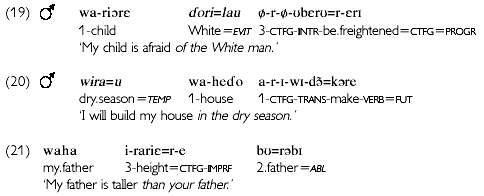
The dynamic locative  is used with figures in motion (23), while the stationary locative
is used with figures in motion (23), while the stationary locative  occurs with static figures (22). While both
occurs with static figures (22). While both  denote more precise paths, the diffuse locative
denote more precise paths, the diffuse locative  denotes more widespread, less 'pinpointable' paths (24) and (25)19.
denotes more widespread, less 'pinpointable' paths (24) and (25)19.
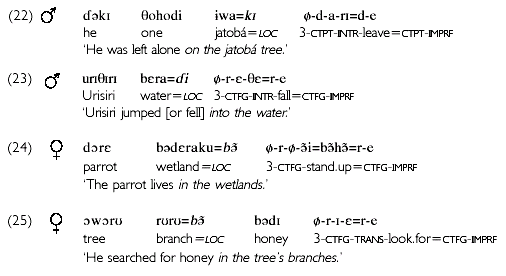
Besides its more clearly locative uses,  can be used to indicate destination (26), time (27) and manner (28) and (29)20. The oblique complements of verbs such as ask, say, call, name, think and tell (that is, the complements denoting that which is said, heard, thought, asked, or told) are also marked by the postposition
can be used to indicate destination (26), time (27) and manner (28) and (29)20. The oblique complements of verbs such as ask, say, call, name, think and tell (that is, the complements denoting that which is said, heard, thought, asked, or told) are also marked by the postposition  (30). As we will see, this semantic diversity accounts for the use of this postposition to mark both purpose clauses and converbs, as well as sentential complements of verbs such as say, tell, etc21.
(30). As we will see, this semantic diversity accounts for the use of this postposition to mark both purpose clauses and converbs, as well as sentential complements of verbs such as say, tell, etc21.
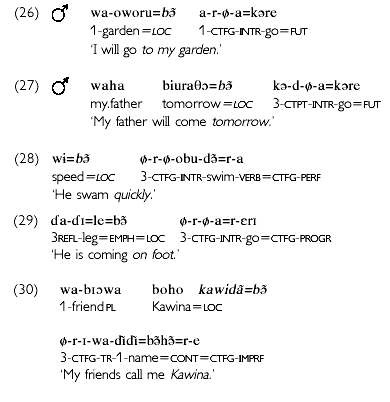
NON-CANONICAL OBJECT MARKING
A number of verbs which would be translated as transitives in English or Portuguese have objects marked by oblique postpositions in Karajá. For example, the verb obi 'to see' takes objects marked by the locative postposition  ehu 'to throw' take complements marked by the instrumental postposition
ehu 'to throw' take complements marked by the instrumental postposition  aha 'to find' takes complements marked by the locative postpositions
aha 'to find' takes complements marked by the locative postpositions  22. The verb
22. The verb  'to drink'
'to drink'  although marked by the prefix
although marked by the prefix  which generally occurs with transitive verbs, takes objects marked by the posposition
which generally occurs with transitive verbs, takes objects marked by the posposition  23.
23.
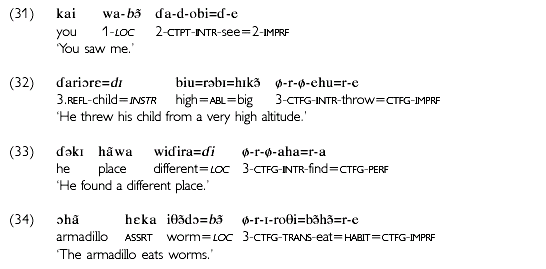
Although they occur with an 'object,' all these verbs behave as intransitives. As such, they do not inflect for voice and cannot incorporate their objects.
RELATIVE CLAUSES
For the sake of terminological clarity, I will adopt here the basic terminology employed by Keenan (1985). Like Keenan, I regard relative clauses to be full NPS (a fact that is rather clear in Karajá, where relative clauses can take articles, as we have seen, and postpositions, as it will be shown below). As Keenan points out, a relative clause typically consists of a common noun (or a pronoun), the domain noun, optionally accompanied by determiners, and a restrictive clause:
Semantically the common noun determines a class of objects, which we shall call the domain of relativization, and the restrictive clause identifies a subset of the domain, those elements which satisfy the conditions given by the restrictive clause (KEENAN, 1985).
Thus, in  'a White man who arrived',
'a White man who arrived',  'White man' is the domain noun, and
'White man' is the domain noun, and  'who arrived' is the restrictive clause. As we have seen, the only surface difference between the independent clause in (1) and its subordinate counterpart in (2) is in the location of the stress:
'who arrived' is the restrictive clause. As we have seen, the only surface difference between the independent clause in (1) and its subordinate counterpart in (2) is in the location of the stress:  'the White man arrived' versus
'the White man arrived' versus  'the White man who arrived'. In fact, stress shift is the basic mechanism to mark the subordinate status of relative clauses that modify core NPS (that is, subjects and direct objects). That the subordinate clause occupies the position of an NP is further demonstrated by the fact that it can be followed by the enclitic indefinite article
'the White man who arrived'. In fact, stress shift is the basic mechanism to mark the subordinate status of relative clauses that modify core NPS (that is, subjects and direct objects). That the subordinate clause occupies the position of an NP is further demonstrated by the fact that it can be followed by the enclitic indefinite article  (36), which attaches to the rightmost element of an NP (35). In addition, an NP modified by a subordinate clause can still act as a possessor, and, in these cases, the possessed noun will occur after the subordinate clause (37)24. Notice that the relative clause is postnominal, occurring after the modified noun. This fact, as we will see ( Nominalized Complements), reflects the general distribution of modifiers in attributive constructions.
(36), which attaches to the rightmost element of an NP (35). In addition, an NP modified by a subordinate clause can still act as a possessor, and, in these cases, the possessed noun will occur after the subordinate clause (37)24. Notice that the relative clause is postnominal, occurring after the modified noun. This fact, as we will see ( Nominalized Complements), reflects the general distribution of modifiers in attributive constructions.
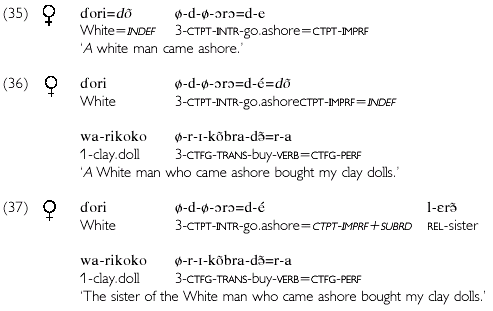
Examples (2), (36), and (37) illustrate restrictive clauses which modify domain nouns in subject position. The examples (38) and (39) illustrate relative clauses modifying the direct objects of the transitive verbs  'to try'
'to try'  'to eat':
'to eat':
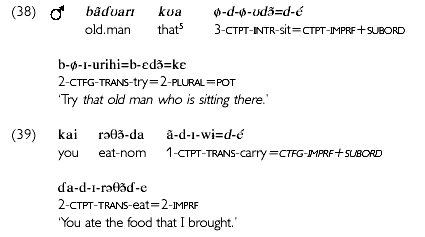
In all the examples, the domain noun occupies the position of a core argument of the verb (subject or direct object), which are not morphologically marked in Karajá. However, when the domain noun is an oblique NP, the postposition that marks such NPS will occur after the restrictive clause, cliticized to the verb (a further argument for the nominal status of the relative clause). Thus, while with core arguments stress shift may be the only surface indicator of subordination, in examples such as (37) the postposition can also be seen as an indicator of the subordinate nature of the clause. Notice that stress shift also occurs in those cases in which the subordinate verb is followed by an article or a postposition. In such cases, however, stress shift may be analyzed as being triggered by the article or the postposition (Possible origins of the subordinating accent). Stress shift will only be indicated in this paper in cases in which it is the only surface marker of subordination.
In (40), the relative clause modifies the object of the verb  which is marked by the postposition
which is marked by the postposition  as we have seen (34). The postposition marking the object will occur after the relative clause. This is further illustrated by examples of relative clauses modifying the objects of the postpositions
as we have seen (34). The postposition marking the object will occur after the relative clause. This is further illustrated by examples of relative clauses modifying the objects of the postpositions 
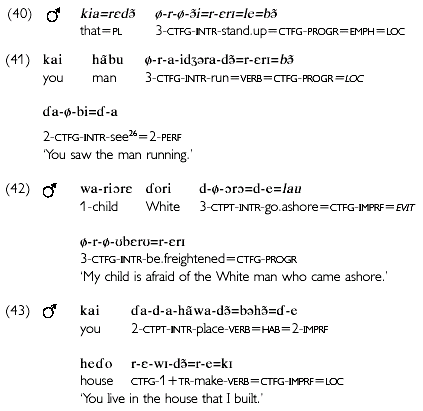
Internal versus external relative clauses
Another important distinction is between internal and external relative clauses, according to the location of the domain noun (whether inside or outside the relative clause, respectively) (KEENAN, 1985). In all the examples given so far, the domain nouns are inside the relative clauses. However, examples in which the domain noun is outside the relative clause are also easily attested.

When an oblique domain noun is separated from the relative clause, notice that the postposition marking the oblique NP occurs twice – with both the domain noun and the subordinate clause. That is, the stranded relative clause agrees in case with the domain noun:
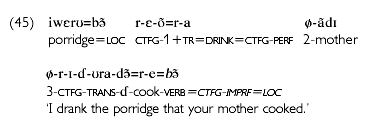
Pronoun retaining strategies
In the previous sections, we concentrate on the syntactic properties of the domain nouns. In this section, attention will be given to the relativized position – that is, the position in the relative clause which is co-referential with the domain noun. In all the examples of relative clauses presented so far, the relativized position corresponds to a core argument of the subordinate clause – either the subject, as in (38), or the direct object, as in (39). As these examples show, there is no surface indication of which position is relativized, which is indicated by gapping – that is, the relativized NP is simply absent from the relative clause. This lack of explicit indication of which position is relativized may lead to ambiguity when one has a third-person transitive verb with a third-person object. Thus, in both examples, the relativized position may be interpreted as being either the subject or the direct object of the subordinate clause:
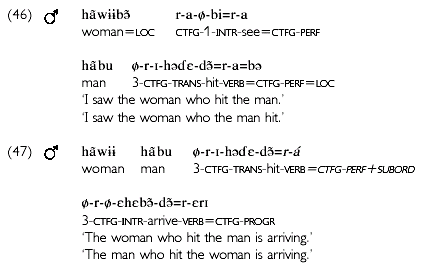
Subject and direct objects are the positions which tend to be more easily relativizable cross-linguistically, when compared with other syntactic positions. The hierarchy of which positions are more likely to allow relativization is thus summarized by Keenan and Comrie (1977):

While subject and direct object relativized positions are not marked in Karajá, relativized positions occupying a lower position in the accessibility hierarchy are marked by a third-person pronominal form. That is, relativization of any syntactic position besides subject and direct object is accomplished through 'pronoun retaining' strategies. This is the case for objects of all the postpositions (including the dative, which behaves as any other oblique NP in the language, and objects of comparison), as well as possessors. Examples of relativized locative (49), ablative (50), and genitive (51) positions:
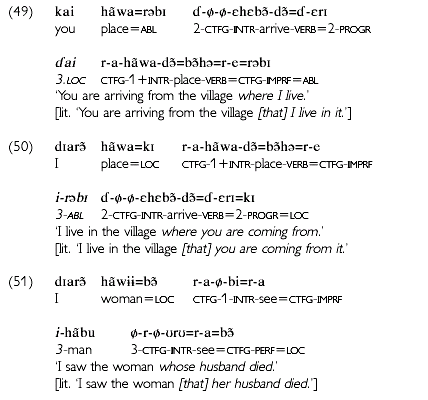
Possible origins of the 'subordinating accent'
As we have seen, stress shift plays an important role in subordination in Karajá. This device – which we may call 'subordinating accent' – is reminiscent of the 'definite accent' in Tonga, described by Anderson (1992) as an example of non-affixal clitic. In this language, according to Anderson, "the normal location of stress is on (the syllable containing) the penultimate mora. A sort of definiteness is marked by a stress shift to the final mora of the entire NP". In this case, the stress shift is explained as being the reflex of a demonstrative morpheme *a which would have existed diachronically.
A similar state of affairs may very well have been the diachronic source of the 'subordinating accent' in Karajá. The shift could have been originally triggered by a subordinating morpheme of some sort27, which would have later disappeared, leaving stress shift as evidence of its diachronic existence. In fact, stress shift is not restricted to subordination environments, but occurs regularly whenever a clitic tense-aspect marker morpheme is followed by a postposition or another tense-aspect marker. Thus, for example, although the imperfective marker  is intrinsically unstressed, it becomes stressed when followed by the future marker
is intrinsically unstressed, it becomes stressed when followed by the future marker  as in the examples (52):
as in the examples (52):

Another possible origin would be a more general, delimiting use of stress (common in languages where stress is predictable), to mark the boundaries of the noun phrase. However, given the lack of comparative evidence, one can only speculate on the origins of such phenomenon28.
Previous descriptions
In spite of its extreme pervasiveness, the phenomenon of the 'subordinating accent' was not mentioned in previous accounts of Karajá grammar (FORTUNE, D.; FORTUNE, G., 1964; FORTUNE, D.; 1970; FORTUNE, D.; 1973; MAIA, 1998). In his typological study, Maia states that he was able to find "hypothetical relative constructions" only through direct elicitation, "similar structures not being detected in the texts analyzed" (MAIA, 1998)29. The 'hypothetical' here relates to the fact that he could not identify any relative pronoun (or any subordinating morpheme, for that matter) in the constructions considered. Notwithstanding this, the examples of 'hypothetical relative constructions' that he provides (reproduced in (53) and (54) with my own transcription and morphological segmentation) very likely presented the stress shift illustrated. Since Maia relies on the rather inaccurate orthography used in Karajá schools, the stress shift went unnoticed in his analysis30.
Maia's examples of "hypothetical relative constructions" reanalized (MAIA, 1998)31
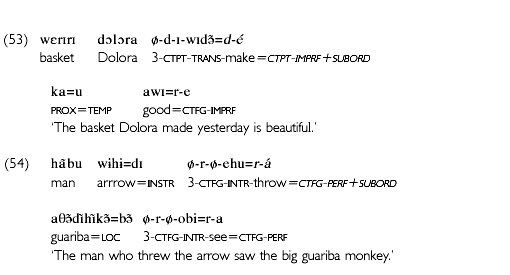
COMPLEMENTATION
Complement clauses are those which occupy the position of a noun phrase, occuring as arguments of the verb or as objects of postpositions. Like relative clauses, complement clauses in Karajá are also characterized by stress shift. In (55), the subordinate clause is the subject of the main clause, whereas in (56), the subordinate clause is the object of the verb 
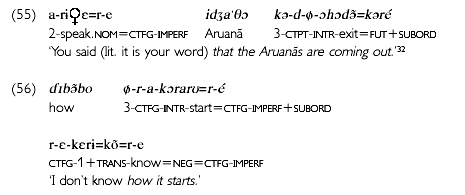
With predicates of saying and thinking, such as ask, say, call, name, think, and tell, the complements denoting that which is said, told, heard, or thought are marked by the postposition  examples (57-61). Therefore, sentential complements of these verbs will also be marked by this postposition. The same happens to complements of the verb obi 'to see'.
examples (57-61). Therefore, sentential complements of these verbs will also be marked by this postposition. The same happens to complements of the verb obi 'to see'.
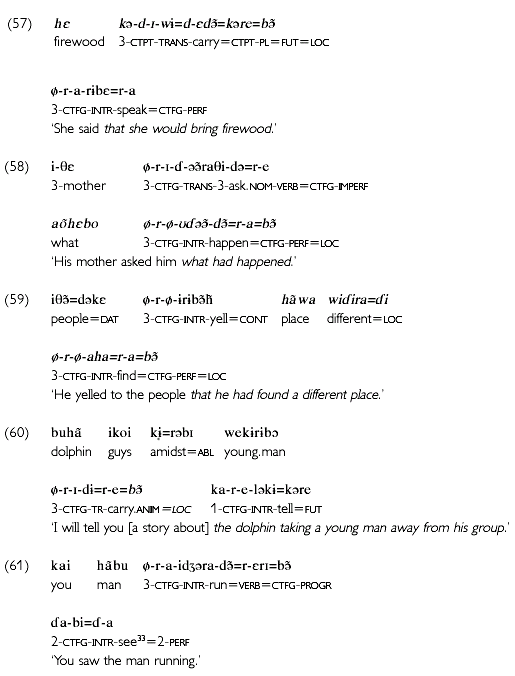
As we will see in the following section, functional equivalents of adverbial clauses in Karajá can also be seen as complement clauses occupying the position of NPS in a postpositional phrase.
ADVERBIAL CLAUSES
Karajá apparently has few, if any, true adverbial clauses34, a fact that mirrors the overall lack of adverbs in the language35. Corresponding to locative adverbs ('here', 'there', 'hither', 'thither') and temporal adverbs ('yesterday', 'tomorrow'), Karajá has demonstrative pronouns  followed by postpositions
followed by postpositions  'the day before yesterday; the day after tomorrow'). Corresponding to manner adverbs ('quickly', 'swiftly', etc.), Karajá has nouns followed by the postposition
'the day before yesterday; the day after tomorrow'). Corresponding to manner adverbs ('quickly', 'swiftly', etc.), Karajá has nouns followed by the postposition  Thus, just as most adverbial functions are played by postpositional phrases, functions traditionally associated with adverbial clauses are played by 'postpositional clauses' in Karajá. Examples of allative, locative and temporal clauses are:
Thus, just as most adverbial functions are played by postpositional phrases, functions traditionally associated with adverbial clauses are played by 'postpositional clauses' in Karajá. Examples of allative, locative and temporal clauses are:
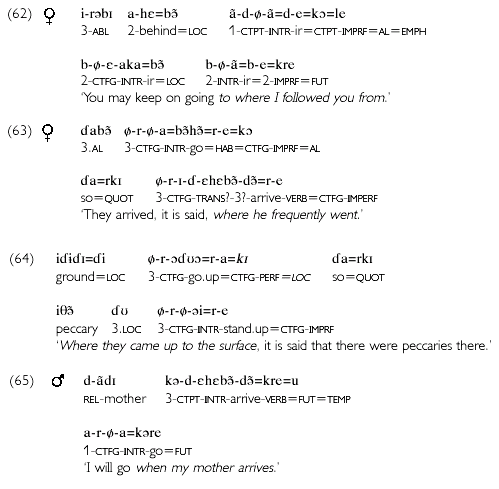
Notice that these adverbial-like subordinate clauses are structurally identical to relative clauses which modify oblique domain nouns (as seen in Relative Clauses), except for the lack of a domain noun. That is, the locative clauses can be analyzed as headless relative clauses. This structural identity between relative clauses and adverbial clauses is not unusual. As Thompson and Longacre (1985) point out, adverbial clauses expressing time, location, and manner can commonly be paraphrased, in many languages, "with a relative clause with a generic and relatively semantically empty head noun: time, place, and way/manner, respectivelly"; such clauses have also in common the fact that they can be replaced by a single word, an adverb, such as today (time), here (location), and quickly (manner) in English and other languages with a clear class of adverbs.
In Karajá, however, not only temporal, locative, and manner adverbial notions are expressed through postpositional clauses. As we will see, purpose, conditional, and reason adverbial clauses, as well as converbs (subordinate clauses denoting a wide range of circumstantial meanings), are also constructed with postpositions. Thus, (notional) adverbial clauses in Karajá can be seen as complement clauses occupying the NP node in a postpositional phrase, being structurally identical with both relative and complement clauses.
Purpose
Purpose clauses are constructed with the postposition  attached to verbs in the future or potential. This is probably an extension of the use of this postposition to indicate destination (see Postpositions)36.
attached to verbs in the future or potential. This is probably an extension of the use of this postposition to indicate destination (see Postpositions)36.

Reason
Subordinate clauses indicating the cause of the event denoted by the main clause are formed with the locative postposition 

Conditional
There are two ways of forming conditional clauses: with the locative postposition =kI attached to potential verbs (1) or with the comitative postposition  (2)37.
(2)37.
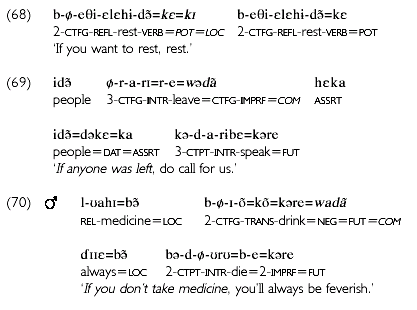
Converbs
Converbs are by far the most common subordinate clauses in Karajá. Converbs, marked by the postposition  indicate that the event denoted by the subordinate clause is somehow related to the event coded by the main clause, signaling a range of circumstantial meanings, including manner, (71) and (72); temporal sequence, (73); simultaneity, (74) and (75); and relationships of cause and effect, (76).
indicate that the event denoted by the subordinate clause is somehow related to the event coded by the main clause, signaling a range of circumstantial meanings, including manner, (71) and (72); temporal sequence, (73); simultaneity, (74) and (75); and relationships of cause and effect, (76).
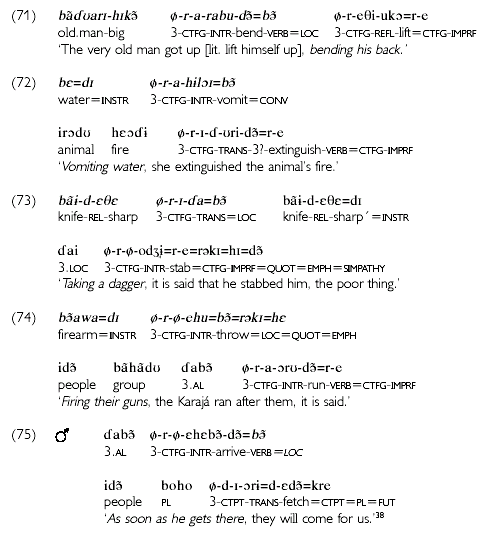
Haspelmath (1995) defines converb as "a nonfinite verb form whose main function is to mark adverbial subordination" [his emphasis] "Another way of putting it", he adds, "is that converbs are verbal adverbs, just like participles are verbal adjectives"39. At first, there seems to be no reason to distinguish converbs from the other postpositional phrases described in the preceding sections. However, there is a crucial difference between them: while the clauses discussed earlier are commonly marked for tense, converbs generally are not. Since typical finite clauses in Karajá are characterized by the presence of a tense-aspect marker, a distinguishing feature of converbs (as opposed to the other postpositional clauses) is their nonfiniteness (which, according to Haspelmath, is a definitional characteristic of converbs)40.
In the majority of the examples, the converb has the same subject as the main clause, but that is not necessarily the case. As examples (76) and (77) show, converbs with different subjects are also possible.
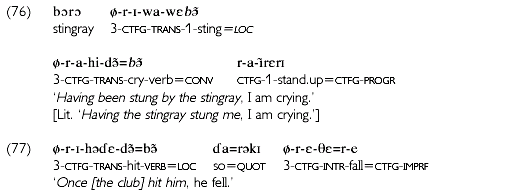
An extremely common use of converbs in discourse is to provide background information previously given, providing a frame for the introduction of new information. Notice that, in such cases, the converb clause is usually a word-by-word repetition of information given in the preceding sentence:

NOMINALIZED COMPLEMENTS
Corresponding roughly to the subordinate clauses described (71-78), one commonly finds nominalized forms of the verbs playing the role of complements. Verb nouns may be preceded by a grammatical possessor which corresponds to the original absolutive argument of the verb – that is, to the subject of an intransitive verb, such as in wa-rira 'my walking' (from rika 'to walk'), or to the object of an intransitive verb, such as in  These constructions occur in any of the functions performed by subordinate clauses (or by any NP, for that matter) – that is, as subjects (79), direct objects (80) or objects of postpositions (81-85)41.
These constructions occur in any of the functions performed by subordinate clauses (or by any NP, for that matter) – that is, as subjects (79), direct objects (80) or objects of postpositions (81-85)41.
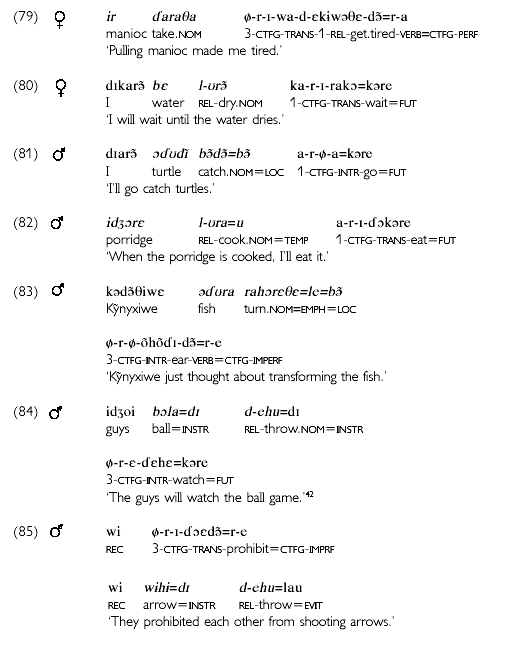
In addition, the suffix  forms subject nouns (that is, nouns refering to the subject of the original verb), which can be translated as relative clauses (86). The suffix
forms subject nouns (that is, nouns refering to the subject of the original verb), which can be translated as relative clauses (86). The suffix  on the other hand, forms nouns which name instruments, places, or other circumstances related to the action denoted by the verb
on the other hand, forms nouns which name instruments, places, or other circumstances related to the action denoted by the verb  'shredder'
'shredder'  'soap (or any washing device)'
'soap (or any washing device)' 

Verb nouns can also be used as (notional) modifiers of other nouns, both as predicates (87a) or attributes (87b). Notice that constructions such as  can be translated as 'washed clothes' or 'the clothes' washing', being structurally identical to genitive phrases43. Notice that the location of the relative clause mirrors the location of the modifier in simple attributive constructions.
can be translated as 'washed clothes' or 'the clothes' washing', being structurally identical to genitive phrases43. Notice that the location of the relative clause mirrors the location of the modifier in simple attributive constructions.

The differences between subordinate clauses proper and constructions involving nominalized verbs are rather straightforward. With subordinate clauses, the verb remains intact, preserving the same inflectional properties and argument structure as in independent clauses. The deverbal nouns discussed in this section, on the other hand, are typical nouns, in that only one argument may be present (as the possessor) and verbal inflectional categories (such as direction and voice) are absent44.
That is, while subordination is clearly a syntactic operation, the creation of deverbal nouns is a matter of derivational morphology. As such, it is subject to the irregularities which generally characterize derivational processes. The following examples illustrate different devices to derive nouns from verbs:  'cooking' (from
'cooking' (from  'to be cooked') and
'to be cooked') and  'drying' (from
'drying' (from  'to dry') are both derived through consonantal replacement, a process by which a velar stop or a glottal fricative in the last syllable of the verb root is replaced with the alveolar flap /r/ in the corresponding nominal form;
'to dry') are both derived through consonantal replacement, a process by which a velar stop or a glottal fricative in the last syllable of the verb root is replaced with the alveolar flap /r/ in the corresponding nominal form;  'catching' (from
'catching' (from  'to catch') is derived by the suffixation of -dV;
'to catch') is derived by the suffixation of -dV;  'turning, transforming'
'turning, transforming'  'to turn; to transform' 'to turn, to transform') is derived by the suffixation of
'to turn; to transform' 'to turn, to transform') is derived by the suffixation of  'taking' (from
'taking' (from  'to take') illustrates both consonantal replacement and the suffixation of
'to take') illustrates both consonantal replacement and the suffixation of  45;
45;  'throwing' (from
'throwing' (from  'to throw') is derived by conversion (or zero-affixation). In addition, a number of verbs have suppletive noun counterparts (cf.
'to throw') is derived by conversion (or zero-affixation). In addition, a number of verbs have suppletive noun counterparts (cf.  'to sit down',
'to sit down',  'sitting';
'sitting';  'to sleep',
'to sleep',  'sleep';
'sleep';  'to lie down',
'to lie down',  'lying down', etc.).
'lying down', etc.).
FINAL REMARKS
Karajá, a Macro-Jê language from Central Brazil, presents a pervasive and straightforward mechanism to create subordinate clauses, shared by relative, complement, and adverbial clauses. This device is 'clause nominalization': an entire clause is nominalized and, as such, can occur in all the positions traditionally occupied by noun phrases (including subject and direct objects, objects of postpositions, and noun modifiers). Clause nominalization (a syntactic process) differs from 'lexical nominalization' (a morphological process) in a number of ways, the main one being that the former preserves all the inflectional properties of the verb. With subordinate clauses occuring in the position of a bare nominal (that is, a noun phrase not followed by postpositions or an article), the subordinate status of the clause is indicated by 'stress shift', an interesting case of non-concatenative.
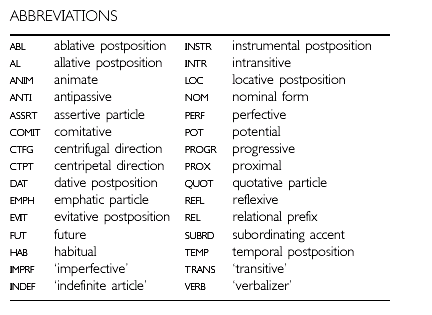
REFERENCES
ANDERSON, Stephen R. 1992. A Morphous Morphology. Cambridge: Cambridge University Press.
BLAKE, Barry. 1994. Case. Cambridge: Cambridge University Press. Cambridge Textbooks in Linguistics.
BORGES, Mônica Veloso. 1997. As falas masculina e feminina em Karajá. Goiânia: Universidade Federal de Goiás. Tese (Doutorado).
FORTUNE, David Lee. 1970. Karaja Grammar: a preliminary transformational-generative study of a brazilian language. Thesis (M.A.) – Department of Linguistics, Indiana University, Indiana.
FORTUNE, David. 1973. Gramática Karajá: um estudo preliminar em forma transformacional. Brasília, DF: SIL. p. 101-161. (Série Lingüística , n. 1).
FORTUNE, David; FORTUNE, Gretchen. 1964. Karajá grammar. Rio de Janeiro: Arquivo Lingüístico do Museu Nacional. Unpublished manuscript.
FORTUNE, David; FORTUNE, Gretchen. 1975. Karajá men's women's speech differences with social correlates. Rio de Janeiro: Instituto de Antropologia Prof. Souza Marques. (Arquivos de Anatomia e Antropologia, n. 1).
HASPELMATH, Martin. 1995. The converb as a cross-linguistically valid category. In: HASPELMATH, Martin (Ed.). Converbs in cross-linguistic perspective: structural and semantic aspects of adverbial verb forms. Berlin: Mouton de Gruyter. p. 1-55.
JESPERSEN, Otto. 1965. The Philosophy of Grammar. New York: Norton.
KEENAN, Edward. 1985. Relative clauses. In: SHOPEN, T. (Ed.). Language Typology and Syntactic Description . Cambridge: University Press. p. 141-170. v. 2.
KEENAN, Edward; COMRIE, Bernard. 1977. Noun Phrase accessibility and universal grammar. Linguistic Inquiry, v. 8, n. 1, p. 63-99.
MAIA, Marcus. 1998. Aspectos Tipológicos da Língua Javaé. Munich: LINCOM Europa. (LINCOM Studies in Native American Linguistics, 11). Publication of his 1986 master's thesis; Universidade Federal do Rio de Janeiro.
MAIA, Marcus. 2002. O mediativo em Karajá. In: SANTOS, Ludoviko; PONTES, Ismael (Ed.). Línguas Jê: estudos vários. Londrina: Editora UEL. p. 147-173.
RIBEIRO, Eduardo. 1996. Morfologia do verbo Karajá. Tese (Mestrado) – Universidade Federal de Goiás, Goiânia.
RIBEIRO, Eduardo. 2000. [ATR] vowel harmony and palatalization in Karajá. Santa Barbara Papers in Linguistics, Santa Barbara, University of California, v. 10, p. 80-92. Proceedings of WAIL 2000.
RIBEIRO, Eduardo. 2002a. Direction in Karajá. In: FERNÁNDEZ, Zarina Estrada; CISCOMANI, Rosa María Ortiz (Ed.). Memorias: VI Encuentro Internacional de Lingüística en el Noroeste. Hermosillo, Sonora, Mexico: Editorial UniSon. p. 39-58.
RIBEIRO, Eduardo. 2002b. Directionality in vowel harmony: the case of Karajá (Macro-Jê). In: LARSON, Julie; PASTER, Mary (Ed.). Proceedings of the 28th Annual Meeting of the Berkeley Linguistics Society: general session and parassession on field linguistics Berkeley. Berkeley: Berkeley Linguistics Society. p. 475-485.
RIBEIRO, Eduardo. (forthcoming a). Valence, voice, and noun incorporation in Karajá. In: PROCEEDINGS from the 27TH meeting of the Berkeley Linguistics Society. [S.l.:s.n.].
RIBEIRO, Eduardo. (forthcoming b). Prefixos relacionais em Jê e Karajá: um estudo histórico-comparativo. In: LIAMES -Línguas Indígenas da América do Sul, 3. Campinas: Universidade Estadual de Campinas. Special Edition. Proceedings of the II Encontro Macro-Jê.
RIBEIRO, Eduardo. (forthcoming c). Análise morfológica de um texto Karajá. In: RODRIGUES, Aryon; CABRAL, Ana Suelly (Ed.). Estudos sobre Línguas Indígenas II. Brasília: Editora da UNB.
RIBEIRO, Eduardo. 2003. A brief note on Maxakalí. Disponível em: <www.etnolinguistica.org>.
RIBEIRO, Eduardo. 2004. Direction and evidentiality in Karajá. Boston: [s.n.]. Paper presented at the Meeting of the Society for the Study of the Indigenous Languages of the Americas.
RODRIGUES, Aryon. 1953. Morfologia do verbo Tupi. Letras, Curitiba, v. 1, p. 121-152.
RODRIGUES, Aryon. 1994. Grammatical affinities among Tupí, Karíb, and Macro-Jê. Brasilia, DF: Universidade de Brasília. Unpublished manuscript.
RODRIGUES, Aryon. 2000. Flexão relacional no tronco lingüístico Macro-Jê. Disponivel em: <http://www.abralin.org.br/boletim/boletim25_tema14.html>. Paper presented at the ABRALIN/SBPC Annual Meeting, July.
SHOPEN, Timothy (Ed.). 1985. Language Typology and Syntactic Description. Cambridge: Cambridge University Press. v. 3.
SILVA, Maria Amélia Reis; SALANOVA, Andrés Pablo. 2000. Verbo y ergatividad escindida en Mebêngôkre. In: VOORT, Hein van der; KERKE, Simon van de (Ed.). Ensayos sobre lenguas indígenas de las tierras bajas de Sudamérica. Leiden: CNWS. p. 225-242. Contribuciones al 49o Congreso Internacional de Americanistas en Quito 1997.
TALMY, Leonard. 1985. Lexicalization patterns: semantic structure in lexical forms. In: SHOPEN, Timothy (Ed.). Lexicalization exicalization patterns patterns: semantic structure in lexical forms. Cambridge: Cambridge University Press, p. 57-149.
THOMPSON, Sandra; LONGACRE, Robert. 1985. Adverbial clauses. In: SHOPEN, Timothy (Ed.). Adverbial clauses clauses. Cambridge: Cambridge University Press, p. 171-234.
 Mailing address:
Mailing address:
Editora do Museu Paraense Emílio Goeldi
Av. Magalhães Barata, 376 São Braz
CEP 66040-170
Caixa Postal 399
Telefone/fax: 55-91-3219-3317
E-mail: boletim@museu-goeldi.br
Recebido:15/11/2003
Aprovado: 02/12/2005
1Karajá has four mutually intelligible dialects (Northern Karajá, Southern Karajá, Javaé, and Xambioá), spoken by around three thousand speakers, in several villages along the Araguaia River, in Central Brazil. The data in this paper are from the Northern and Southern Karajá dialects, but the phenomena here described are common to all four dialects. I would like to thank all the Karajá speakers, who took the time to teach me their language (particularly Ijeseberi, Luiz Kurikala, and Sinvaldo Wahuka), patiently and generously.
2  'assertive' occurs in clauses reporting a well-known or obvious fact, a matter-of-factly type of information, exactly the contrary of what Maia (2002) claims its meaning to be. Maia considers it a 'dubitative particle,' claiming that "
'assertive' occurs in clauses reporting a well-known or obvious fact, a matter-of-factly type of information, exactly the contrary of what Maia (2002) claims its meaning to be. Maia considers it a 'dubitative particle,' claiming that "  introduces an element of doubt" (my translation). In fact,
introduces an element of doubt" (my translation). In fact,  is extremely common exactly in contexts in which the veracity and accuracy of the information is not at question, such as descriptive (8) and autobiographic (i, ii) texts.
is extremely common exactly in contexts in which the veracity and accuracy of the information is not at question, such as descriptive (8) and autobiographic (i, ii) texts.

3The same set of prefixes is used for singular and plural. There is also a distinction between a first person plural exclusive (marked by the same set of prefixes used for first person singular – except in the centrifugal direction of the irrealis, when the prefix  koccurs) and a first person plural inclusive (inflected for third person). The prefix
koccurs) and a first person plural inclusive (inflected for third person). The prefix  '3rd person' (7) is restricted to the centripetal direction of the irrealis mood.
'3rd person' (7) is restricted to the centripetal direction of the irrealis mood.
4Notice, however, that the prefix  which occurs with class ii verb stems may be treated as a third-person object marker.
which occurs with class ii verb stems may be treated as a third-person object marker.
5As such, they can occur with any word classes, including nouns ( '[he] is your father'), pronouns (
'[he] is your father'), pronouns ( 'it will be me'), postpositions (
'it will be me'), postpositions ( 'it was during Watau's youth'), and numerals (
'it was during Watau's youth'), and numerals ( 'it is two'). In addition, in desiderative constructions such as the example (i), tense-aspect morphemes can be separated from the verb by a postposition (which act as a subordinating morpheme). Notice that, in constructions such as these, the clitic auxiliary functions syntactically as a full verb such as
'it is two'). In addition, in desiderative constructions such as the example (i), tense-aspect morphemes can be separated from the verb by a postposition (which act as a subordinating morpheme). Notice that, in constructions such as these, the clitic auxiliary functions syntactically as a full verb such as  'he is crying' (ii). Notice also that the clitic auxiliaries inflect for direction (and, in the second person, also for subject agreement), an atypical behavior for an 'affix'.
'he is crying' (ii). Notice also that the clitic auxiliaries inflect for direction (and, in the second person, also for subject agreement), an atypical behavior for an 'affix'.

6Although basically unstressed, clitics such as the tense-aspect morphemes and postpositions become stressed when attached to monosyllabic stems:  'with firewood'
'with firewood'  'he will go'
'he will go' 
7There distribution of these two allomorphs of the relational prefix,  (such as in
(such as in  'hand') and
'hand') and  (such as in
(such as in  'medicine'), is not phonologically conditioned, and is subject to dialectal variations with some stems. As mentioned in Phonology, the relational prefix and the third person prefix
'medicine'), is not phonologically conditioned, and is subject to dialectal variations with some stems. As mentioned in Phonology, the relational prefix and the third person prefix  are palatalized before [high, +ATR] vowels, being pronounced as
are palatalized before [high, +ATR] vowels, being pronounced as  and
and  respectively:
respectively:  'tooth'
'tooth'  'his tooth'
'his tooth'  .
.
8Although all class II stems are vowel-initial and most of class I stems are consonant-initial, the distinction cannot be reduced to phonological terms, since class I also includes some vowel-initial stems, such as  'to gather',
'to gather',  'younger brother', etc.
'younger brother', etc.
9Although the prefix  may be analyzed as a third-person object marker in examples such as this, that is not always the case. Stems containing this prefix also occur in clearly intransitive constructions, including antipassive (a process resulting in the syntactic elimination of the direct object position). Although that was probably the original meaning of this prefix (as is still the case with noun stems), its synchronic distribution is somewhat irregular.
may be analyzed as a third-person object marker in examples such as this, that is not always the case. Stems containing this prefix also occur in clearly intransitive constructions, including antipassive (a process resulting in the syntactic elimination of the direct object position). Although that was probably the original meaning of this prefix (as is still the case with noun stems), its synchronic distribution is somewhat irregular.
10Some authors (such as Fortune, D. and Fortune, G. (1964), for Karajá, and Silva and Salanova (2000), for the Northern Jê language Mebengokrê) treat the 'soft' consonant as part of the stem, postulating morphophonemic rules to derive the third-person forms. However, no matter how one analyzes them synchronically (whether as prefixation or consonant gradation of some sort), alternations such as the ones illustrated are found in all three branches of the Jê family (Southern, Central, and Northern), and can be reconstructed for Proto-Jê. I propose elsewhere (RIBEIRO, forthcoming b), phonological correspondences corroborate the hypothesis that the alternations between  and
and  ~
~  in Karajá have the same origin as the ones found in Jê.
in Karajá have the same origin as the ones found in Jê.
11These characteristics seem to point out to a phonologically-motivated origin of the relational prefixes, which may have originated as a sandhi phenomenon between vowel-initial stems and their determiners. As I suggested in an earlier squib (RIBEIRO, 2003), the distribution of relational prefixes may have an interesting diagnostic value in determining the relative age of pronominal prefixes in Macro-Jê. Prefixes that occupy the same morphological slot as the relational prefixes (such as the third-person marker  and the second-person marker Ø- in Karajá) would be older than the ones which co-occur with relational prefixes. This pattern is also attested in Kariri, Ofayé, and Maxakalí (in the latter, as a morphologically relic) (RIBEIRO, 2003). The zero second-person marker with class II stems is likely a result of the coalescence of the prefix a- when attached to vowel-initial stems. The few class I stems which are vowel-initial may have been originally consonant-initial, the initial consonant having been dropped after the distinctions between class I and class II were already in place.
and the second-person marker Ø- in Karajá) would be older than the ones which co-occur with relational prefixes. This pattern is also attested in Kariri, Ofayé, and Maxakalí (in the latter, as a morphologically relic) (RIBEIRO, 2003). The zero second-person marker with class II stems is likely a result of the coalescence of the prefix a- when attached to vowel-initial stems. The few class I stems which are vowel-initial may have been originally consonant-initial, the initial consonant having been dropped after the distinctions between class I and class II were already in place.
12In Tupinambá, non-obligatorily possessed class II stems such as óka 'house' and uúba 'arrow' indeed occur without any prefix in their citation form, a fact which rules out the analysis of Tupinambá s- as a 'non-contiguity marker' The same is true for Karirí, where class II stems such as era 'house' also occur without any prefix in their unpossessed form.
13With two kinship terms, adI 'mother' and  'sister', unpossessed forms with the relational prefix have a first-person meaning, probably as a consequence of the vocative use of these stems: d-adI 'my mother',
'sister', unpossessed forms with the relational prefix have a first-person meaning, probably as a consequence of the vocative use of these stems: d-adI 'my mother',  'you mother',
'you mother',  'his mother' (but *
'his mother' (but * 'my mother');
'my mother'); 'my sister',
'my sister',  'your sister',
'your sister',  'his sister' (but *
'his sister' (but * ) 'my sister'). While the stem
) 'my sister'). While the stem  can occur with nominal possessors (
can occur with nominal possessors (  'the White man's sister'),
'the White man's sister'),  cannot (the stem
cannot (the stem  being used instead:
being used instead:  'the White man's mother').
'the White man's mother').
14Both the allative postposition  and the dative postposition
and the dative postposition  mark the recipient or the direction of a given process. Although both can occur with nouns,
mark the recipient or the direction of a given process. Although both can occur with nouns,  seems to occur only with [+animate] nouns, while
seems to occur only with [+animate] nouns, while  can occur with both [+animate] and [-animate] nouns. Because of this semantic constraint,
can occur with both [+animate] and [-animate] nouns. Because of this semantic constraint,  occurs more frequently in functions that are traditionally associated with that of datives. As mentioned before,
occurs more frequently in functions that are traditionally associated with that of datives. As mentioned before,  do not take prefixes. Thus, corresponding to both postpositions, there is only one set of inflected forms:
do not take prefixes. Thus, corresponding to both postpositions, there is only one set of inflected forms:  'to me',
'to me',  'to you',
'to you',  'to him',
'to him',  'to himself'.
'to himself'.
15As I suggest elsewhere (Ribeiro forthcoming c), considering that all three suppletive third-person forms begin with  , it is likely that they are relics of class II postpositional paradigms. That is, the first consonant in
, it is likely that they are relics of class II postpositional paradigms. That is, the first consonant in  and
and  would have been third-person forms of postpositions which are no longer in use. In that case,
would have been third-person forms of postpositions which are no longer in use. In that case,  would have been diachronically the third-person form (< *
would have been diachronically the third-person form (< * ) of a class II postposition
) of a class II postposition  while the prefix
while the prefix  would trace back to a second-person form of the same postposition
would trace back to a second-person form of the same postposition  which was later reinforced by the postposition
which was later reinforced by the postposition  This would help to explain the rather limited distribution of this prefix.
This would help to explain the rather limited distribution of this prefix.
16Other morphemes, such as  'in front of' (♂ ko) and
'in front of' (♂ ko) and  'equative', may be added to this list, although their syntactic status is not as clear as the one of the postpositions listed in Table 6. Like noun stems, they can be followed by postpositions. Unlike noun stems, they may, in certain circumstances occur in adverbial functions without any marker of adverbial status. Their syntactic properties are reminiscent of the noun home in English, which can, in certain constructions, occur with adverbial functions without any preposition (I brought you home, but *I brought you to home). Since a thorough description of their behavior is beyond the scope of this paper, they will not be further discussed here.
'equative', may be added to this list, although their syntactic status is not as clear as the one of the postpositions listed in Table 6. Like noun stems, they can be followed by postpositions. Unlike noun stems, they may, in certain circumstances occur in adverbial functions without any marker of adverbial status. Their syntactic properties are reminiscent of the noun home in English, which can, in certain constructions, occur with adverbial functions without any preposition (I brought you home, but *I brought you to home). Since a thorough description of their behavior is beyond the scope of this paper, they will not be further discussed here.
17A good example of the problem posed by the translation of adpositions is the preposition by in English, which has instrumental ( he went by train), locative ( he is by the fountain), and temporal ( I'll be back by midnight) uses, among others. The criteria to determine the 'basic' meaning of postpositions may be fairly arbitrary. In labeling the Karajá pospositions, I took into consideration what seems to be their more general, productive, and non-idiomatic uses (as far as possible).
18Kariri, a Macro-Jê language remotely related to Karajá, also has an evitative postposition (MAMIANI, 1877). According to Blake (1994), evitative (also called 'aversive') case markers are also common in Australian languages.
19These semantic characterizations are approximations. For the concepts of figure and path adopted here, see Talmy (1985), who defines figure as "the salient moving or stationary object in a motion event" and path as a category which "refers to the variety of paths followed, or sites occupied, by the Figure object".
20Although the range of meanings displayed by some of the Karajá pospositions may at first seem unusual, it is very easy to find parallels in other, well-known languages such as English or Portuguese. The use of locative postpositions with temporal purposes (as a metaphorical extension from location in space to location in time), for example, is a rather common phenomenon. Even more idiosyncratic uses of postpositions (as non-canonical markers of what would be translated as direct objects in English) may also reflect cross-linguistic tendencies. As Jespersen (1965) points out, verbs for 'to throw' take objects marked as instrumentals in many languages, including Old Norse. The use of a locative posposition to mark the object of a verb such as  is paralleled in English by the use of on in constructions such as deer feed on grass or the castaway lived on coconuts for weeks.
is paralleled in English by the use of on in constructions such as deer feed on grass or the castaway lived on coconuts for weeks.
21This apparent diversity of meanings could be due not to polysemy, but to homophony (that is, instead of these being instances of different meanings associated with a single postposition, it could be the case that there would be different postpositions with the same phonological shape). However, the fact that a postposition such as  presents the same irregular allomorphy in all the uses mentioned seems to rule out the hypothesis of accidental similarity.
presents the same irregular allomorphy in all the uses mentioned seems to rule out the hypothesis of accidental similarity.
22As in English or Portuguese, the verb aha 'to find' is also used with an 'evaluative' meaning (as in I found the play annoying). In this case, the evaluative NP is marked by the postposition  :
:

23Another verb which presents a similar irregular behavior is õ 'to drink'.
24Notice that example (37) is only grammatical if  is interpreted as being the head of the preceding construction. As we have seen (see footnote 12),
is interpreted as being the head of the preceding construction. As we have seen (see footnote 12),  has a first person-meaning when occurring by itself, but is otherwise obligatorily possessed.
has a first person-meaning when occurring by itself, but is otherwise obligatorily possessed.
25  'that (distant from both the speaker and the addressee)' is a demonstrative (not a relative pronoun, as the translation of the example may suggest). There are two other demonstratives in Karajá, ka 'this' and kia 'that (close to the addressee)' (see example 40).
'that (distant from both the speaker and the addressee)' is a demonstrative (not a relative pronoun, as the translation of the example may suggest). There are two other demonstratives in Karajá, ka 'this' and kia 'that (close to the addressee)' (see example 40).
26Intransitive class II verb stems such as obi 'to see' lose their initial vowels in the first and second persons of the realis mood: in the example, the underlying form of the verb is 
27This 'subordinating' morpheme could have been a nominal clitic, such as an article (which would thus pair with the indefinite article 
28Sinchronically, one could postulate the existence of a 'zero clitic' to account for the stress shift. Since this more abstract analysis does not necessarily present any analytical advantage, I will adopt a more concrete analysis in this paper, indicating the stress shift whenever necessary.
29Although Maia's statement seems to suggest that relative clauses are less common in texts than in elicited materials, that is certainly not the case. Most examples in this paper were indeed taken from texts, where subordination is extremely common. In fact, all the subordinate clause types here described are highly favored constructions in Karajá grammar.
30The fact that Maia does not signal any pause between both sentences corroborates my analysis of these examples as cases of subordination, not juxtaposition of two independent clauses ('the man threw the arrow; he saw the guariba monkey'), which would be a rather odd construction in Karajá, given the lack of particles marking any type of relation between the last clause and the preceding one.
31Maia's original transcriptions of these examples are weriri Dolora dewinade kau awire and Hãbu wyhy rehura asynihiky-my robina. In addition to the overall shortcomings of Karajá orthography, Maia's transcription also presents some inaccuracies of its own. For example, the verb ehu 'to throw' takes objects marked with the instrumental postposition  , never a 'bare' object as Maia's transcription suggests. This and other inaccuracies are corrected in (53) and (54).
, never a 'bare' object as Maia's transcription suggests. This and other inaccuracies are corrected in (53) and (54).
32 'Aruanãs' are masked dancers who represent forest and underwater spirits. Aruanã festivals are among the most highly anticipated events in Karajá social life.
33 Intransitive class II verb stems such as obi 'to see' loose their initial vowels in the first and second persons of the realis mood. Notice that, in this example, the complement clause could also be translated as a relative clause headed by hãbu 'man' ('You saw the man who is/was running').
34Besides the 'postpositional clauses' described in this paper, a few other constructions can also be probably treated as adverbial clauses. The most common among them is the dokuri-clause, characterized by the presence of the second-position clitic ♀dokuri(♂=dori). Such clauses have an explicative function and can be translated using English for (i) or Portuguese pois ( fique, pois estou indo longe).

Maia (2002) translates ♂=dori as a 'focus marker', which is probably a mistake: being a Wackernagel clitic, it is not surprising that this morpheme occurs after fronted elements, but that is also the case of most discourse-oriented particles in the language. Fortune (1970) translates it (rightly, I think) as 'because'. In fact, its distribution and phonological behavior suggest that =dokuri belongs in the large class of attitude markers, particles that inform on the attitude of the speaker with relation to the utterance (indicating certainty, doubt, excitement, boredom, sympathy, surprise, assertiveness, resolve, etc.). If that is the case, that would help us to explain the differences between dokuri-clauses and the reason clauses described: dokuri-clauses are probably examples of speech act adverbial clauses, whose function, as defined by Thompson and Longacre (1985) "is not to modify or qualify the main clause in any way, but to modify or qualify, as it were, the speech act which the speaker is performing in uttering the main clause". That is a fascinating topic to be further investigated.
35One candidate for adverbhood would be widi 'today, now'  . The locative morphemes
. The locative morphemes  (which, as we have seen, are suppletive third-person forms of postpositions) could also be alternatively analyzed as adverbs. Even if these morphemes are considered as adverbs, this would be a closed class in Karajá.
(which, as we have seen, are suppletive third-person forms of postpositions) could also be alternatively analyzed as adverbs. Even if these morphemes are considered as adverbs, this would be a closed class in Karajá.
36The use of destination adpositions to mark purpose clauses is commonly attested, as in English ( I came to see you) and Portuguese ( eu vim para vê-lo).
37The difference between constructions with =kI and constructions with  is not fully understood yet.
is not fully understood yet.
38 This is one of the few examples of a third-person centripetal verb in the realis that does not occur with the prefix  Possible semantic motivations for the absence of the prefix are being investigated.
Possible semantic motivations for the absence of the prefix are being investigated.
39Similar constructions have been called 'absolutive clauses' by some authors. According to Thompson and Longacre (1985), absolutive "is a cover term for a subordinate clause type in which the following conditions hold: (i) the clause is marked in some way as being subordinate; (ii) there is no explicit signal of the relationship between the main and subordinate clause; thus (iii) the interpretation of this relationship is inferred from the pragmatic and linguistic context". As we have seen, these are exactly the characteristics of the converb constructions in Karajá.
40Although there is a strong tendency for converbs to be nonfinite and for the other postpositional clauses to be finite, that is not a hard and fast rule. Imperative and imperfective verbs may occur without the tense-aspect clitics, but in situations in which this information is easily recoverable through context. Interestingly, the imperfective auxiliary can still trigger vowel harmony even when it is not present on the surface (RIBEIRO, forthcoming c).
41Notice that the deverbal nouns derived from verbs such as ehu preserve the case-marking peculiarities of the original verb.
42 Both  'to watch, to look at' and ehu 'to throw' take objects marked by the instrumental postposition =dI (corresponding to what would be direct objects in English or Portuguese). The 'ball game' [lit. 'the throwing of the ball'] in the example refers, naturally, to soccer.
'to watch, to look at' and ehu 'to throw' take objects marked by the instrumental postposition =dI (corresponding to what would be direct objects in English or Portuguese). The 'ball game' [lit. 'the throwing of the ball'] in the example refers, naturally, to soccer.
43Thus, the notional modifier would indeed be the syntactic head of the attributive constructions. Attributive constructions in Karajá are reminiscent of constructions such as um amor de criança 'a lovely child' [lit. 'a love of a child'], common in Romance languages, in which the notional modifier is actually the head (see Ribeiro 2002b for a thorough description of attributive constructions and descritive predicates in Karajá). Constructions such as (8a) are traditionally analyzed as descriptive verbs in Karajá (FORTUNE, D.; FORTUNE, G., 1964; MAIA, 1998), which is clearly a mistake. The fact that such constructions require a nominal form of the verb stem shows that such descriptive verbs are simply nouns in predicative use.
44For example, while the verb  wÈ 'to carry' can occur in both centripetal and centrifugal directions (
wÈ 'to carry' can occur in both centripetal and centrifugal directions (  'he brought it' versus
'he brought it' versus  'he took it away'), this distinction is neutralized in the nominal form, in such a way that
'he took it away'), this distinction is neutralized in the nominal form, in such a way that  'the one who carries food' can be paraphrased as either 'the one who brings food' or 'the one who takes food away'.
'the one who carries food' can be paraphrased as either 'the one who brings food' or 'the one who takes food away'.
45Notice that in both nominalizing suffixes,  , 'V' is a copy of the last vowel in the verb stem.
, 'V' is a copy of the last vowel in the verb stem.













